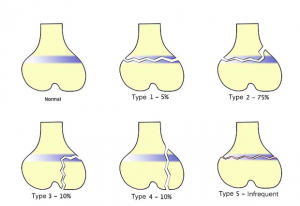Growth Plate Fractures
The growth plate is an area of cartilage near the ends of long bones in children that regulate the length and shape of mature bone. Growth occurs at each end of the bone around the growth plate. When a child becomes full-grown, the growth plates harden into solid bone. Injury to a growth plate occurs in children and adolescents as this region is weaker than the rest of the bone and surrounding structures until it closes and is replaced by solid bone. Approximately 15% of fractures in children involve a growth plate. They are more common in boys and those participating in sports and recreational activities such as biking and skateboarding. It is important to have all fractures evaluated by an orthopedic surgeon to reduce the chance of long-term consequences involving bone deformity.
Although they can occur in any long bone, most growth plate injuries occur in the fingers, distal radius (forearm bone near the wrist), and lower leg bones (tibia and fibula). Fractures can occur from a single traumatic event such as a fall or from overuse activities causing repetitive stress on a bone.
Growth plate injuries are categorized by the type and location of fracture. The most common is the Salter-Harris classification (Please include diagram of Salter-Harris classification).

Type I: Fracture across the entire growth plate, separating the long part of the bone from the end. Often times, this type can be treated with casting; surgical treatment by placing pins in the bone to hold them together may be necessary for proper healing.
Type II: Fracture through part of the growth plate and shaft of the bone. This is the most common type of growth plate injury and occurs in older children. They generally heal well with placement of a cast.
Type III: Fracture through part of the growth plate that extends down the end of the bone and exits in the joint. Surgery is usually required to restore proper bone position to ensure appropriate joint and growth plate healing.
Type IV: Fracture through the bone shaft, across the growth plate, and into the end of the bone which disrupts bone growth. Surgery to align the bone fragments and hold them together is necessary for healing.
Type V: A rare, compression fracture, where the end of the bone is crushed and compressed into the growth plate. There may be permanent growth plate injury causing a growth disturbance with this type of fracture.
Fractures involving the growth plate must be monitored closely for proper alignment and healing to reduce the risk of unfavorable long-term outcomes.
